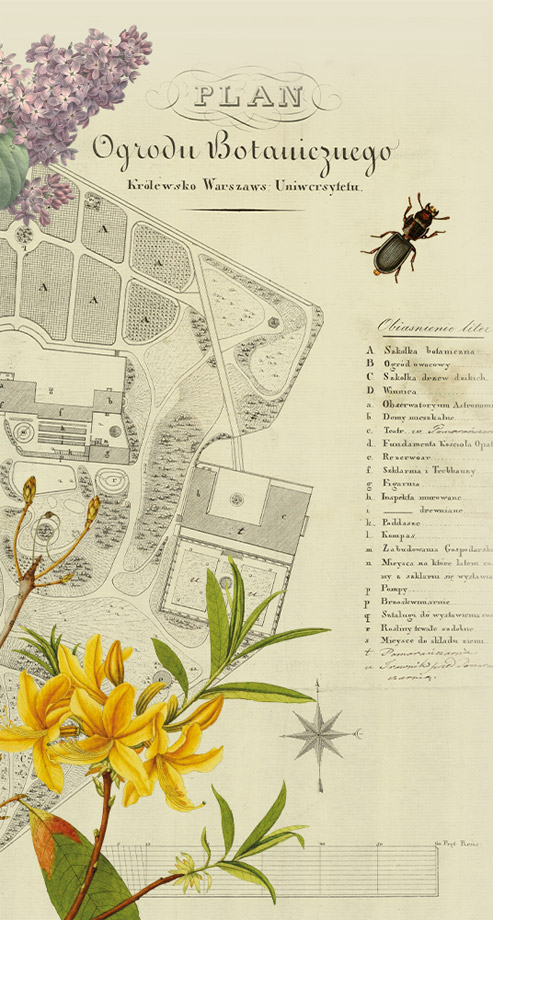History

History of the Garden
The Botanic Garden was founded in 1818 by the efforts of botany professor Michał Szubert. It is a part of the former Royal Gardens, i.e. the northern section of the Łazienki Park. Back then, it covered an area of 22.5 hectares, including the Royal Greenhouses and the Old Orangery.
The Garden’s creator divided the area into three sections: scientific – dedicated to plant systematics, pomological – where a collection of fruit trees was planted with the purpose of educating future gardeners, and the walking area – for the use of the general public.
It wasn’t long before the fame of the new Botanic Garden spread beyond the country’s borders. An inventory of plants grown in the Garden in 1824 lists some 10,000 species and varieties, a thousand of which represented the Polish flora.
The Garden’s further growth was halted after the suppression of the November Uprising. With the closing of the University in 1834, the Garden’s area was reduced by ¾. It has remained so to this day.
In 1846, Michal Szubert was removed from his position as head of the Garden, with the senior gardener Ignacy Hanusz taking over. This event marked the beginning of the decline of the thriving institution.
For several decades onwards, the Garden was in charge of Tzar officials. During this period, both Warsaw press and police took interest in the place.
In 1916, the Botanic Garden was put under the administration of the restored University of Warsaw. Its newly appointed director, professor Zygmunt Wóycicki, energetically set about rebuilding the institution. New sections of plant biology, ornamental plants, and the rose garden were created, and the renovation of the greenhouse was initiated.
In 1919, the Garden’s management was assumed by professor Bolesław Hryniewiecki, a renowned plant systematist and geographer. During his directorship, all greenhouses were rebuilt and equipped with central heating, and the collections of trees and shrubs were enlarged. The Garden regained its former scientific and didactic rank.
During World War II and the Warsaw Uprising all garden buildings and greenhouses were shattered. The park area became a burial ground of the vast collections of the past.
As the war ended, however, people took to restoring the Garden with much enthusiasm and faith. Professor Bolesław Hryniewiecki in team with the doctors Roman Kobendza and Wacław Gajewski embarked on a long and persistent effort to this effect. The demolished buildings and greenhouses were rebuilt within just a few years, and a start was made of restoring the plant collection.
In 1960, associate professor Lyudmila Karpovichova was appointed head of the Garden. Greatly committed to the task, she raised funds for the Garden’s maintenance, expanded the collection, and popularized the knowledge of botany. Through her efforts, in 1965, the UW Botanic Garden was listed in the Register of Monuments of Culture and Science of the Capital City of Warsaw.
After Ludmiła Karpowiczowa’s death in 1973 came the years of stagnation. The Garden, handicapped by the shortage of funds, was losing its rank yet again in history.
In 1987, doctor Hanna Werblan-Jakubiec became the next head of the Garden. Due to her efforts, the historical shape of the plant biology section was restored, and the collections of roses as well as climbing, medicinal and crop plants were reconstructed and enriched. The Garden’s greenhouses were refurbished and upgraded.
As of 2019, the Botanic Garden has been in charge of associate professor Marcin Zych, a biologist, evolutionist researcher and ethnobotanist engaged in studying complex relationships between plants and pollinators.
